FEATURES
Rock Stars
Billion-year-old meteorites travel millions of miles just to land in Cari Corrigan’s Smithsonian lab
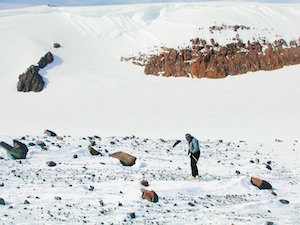 PHOTO: Courtesy of The Antarctic Search for Meteorites Program / Yulia Goreva
PHOTO: Courtesy of The Antarctic Search for Meteorites Program / Yulia GorevaCari Corrigan hunting for meteorites at MacAlpine Hills, Antarctica, during a 2004-2005 trip.
Cari Corrigan, PhD (GRS ’04, geological sciences), has traversed frozen terrain never before touched by human feet to collect pieces of outer space no one has ever seen. These meteorites—dense, black and smooth—may not look like much, but many are billions of years old and helping to unlock the mysteries of our existence.
"Each one is a piece of the bigger puzzle about how our solar system formed," she said. "They can tell us where we came from."
As curator of Antarctic meteorites at the Smithsonian’s National Museum of Natural History’s Department of Mineral Sciences in Washington, D.C., Corrigan oversees and classifies every extraterrestrial rock that American researchers have retrieved from the bottom of the world—about 23,000 to date.
One rock from the collection—Allan Hills 84001, a nearly 5-pound Martian meteorite—contributed to the interest in exploring Mars, as tantalizing questions began to swirl in the mid-1990s about the possibility of life on the red planet. It’s because of other meteorites that we know Earth has a core made of nickel and iron metal, and that the solar system is about 4.6 billion years old.
In her museum lab on the National Mall, Corrigan separates what she calls "run-of-the-mill, out-of-this-world rocks" from the 10% that are unusual or even rock stars, like Martian and lunar meteorites; fields requests for samples from researchers; and occasionally answers questions about an asteroid millions of miles away that was named in her honor.
"I’m continually astounded that I get paid to do something this cool," she said.
Perhaps fittingly for someone who spends her days with rocks formed by intergalactic collisions, Corrigan’s own journey has resulted from serendipitous encounters.
Raised in a small town in western Michigan, Corrigan felt as if the universe opened up before her when she discovered planetary sciences in college. An internship led to chance meetings with Ralph Harvey, PhD, now a Case Western Reserve University professor of planetary materials who later became her doctoral adviser, and geologist Tim McCoy, PhD, now curator of meteorites at the National Museum of Natural History.
It was Harvey who, in 2001, guided Corrigan on her first adventure to Antarctica, the frozen continent that continues to capture her imagination, and McCoy who hired her at the museum seven years later.
Corrigan is one of only a few people "who have experienced Antarctic meteorite research end to end," McCoy said. "From her experience on the collecting team through curation to classification and finally research, her career has touched on every aspect of the remarkable objects and the stories they tell about the origin and history of our solar system."
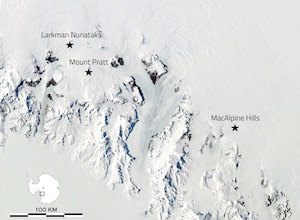 PHOTO: NASA
PHOTO: NASASome locations in Antarctica that Corrigan has visited.
SUMMERING IN THE SOUTH POLE
Every day, between 30 and 100 tons of meteorites rip into Earth’s atmospheric gases at about 13 miles per second, and then the vast majority vaporize. Those that survive crash-land randomly over the globe, ending their journey at the bottom of the ocean or on land, where they’re often obscured by plants or camouflaged by Earth rocks.
But not so in Antarctica, which is blanketed by snow and ice. "If you want to find stuff falling from the sky, just lay out a big, white sheet," said Harvey, who’s traveled to Antarctica two-dozen times since 1987 and is the longtime principal investigator with the Antarctic Search for Meteorites (ANSMET), a research collaboration between Case Western Reserve and the University of Utah. Founded in 1976 and funded by NASA, ANSMET is the biggest group of its kind.
Corrigan was a doctoral student when she first traveled to Antarctica in 2001 with ANSMET. It was November—summertime in the South Pole, when highs average a balmy minus 5 degrees Fahrenheit. Forty-five mile-per-hour winds can cause the temperature to feel like minus 40. "It’s one of the harshest environments in the world," Harvey said.
Before teams embark on six weeks of meteorite-hunting together, they are trained to survive extreme weather and utter seclusion. At McMurdo Station, the U.S. research center on the southern tip of Ross Island, they learn to pitch a tent during a windstorm, drive a snowmobile, pluck someone out of an icy crevasse and administer first aid.
"When the pilots fly you out to the [field], they make you pitch your tent to create a safe shelter, then they fly away. Watching them leave is terrifying," Corrigan said.
The eerie feeling of isolation during her first of two trips was amplified by its timing: just two months after 9/11.
Communication was spotty at best. "There was this sense [because of the terrorist attacks] that the world could end and we might not even know it," she recalled. "To make a five-minute call or type out a few sentences of an email, the satellites had to be in exactly the right place in the sky"—something that happened only a few times a day.
"But then you take in the scenery," Corrigan said, a smile spreading across her face. "It’s more glorious than you could ever imagine: big, wide-open blue skies, or crazy clouds in all kinds of amazing shapes, and nothing made by humans in your field of view. The sense of being alone is surprisingly peaceful."
To prepare for a 9-to-5 shift behind the wheel of a snowmobile, combing the terrain for meteorites, Corrigan would wrap nearly every inch of her body in layers of fabric, including long underwear, expedition-weight fleece pants and a sweatshirt, snow pants, a wind-proof jacket and a down parka. On her feet: sock liners, wool socks and military- grade "bunny boots," bulbous, waterproof shoes that feature an inch of wool insulation between two vacuum-tight layers of rubber. Windproof fleece gloves, a fleece face mask, neck gaiter, hat and prescription sunglasses completed the ensemble.
Corrigan, who kept her brown curls in braids, went six weeks with only sponge baths.
"It’s so cold [in the field] that you don’t sweat, and you can’t smell very well. But when you get back, look out," she laughed. "I still remember that first shower at McMurdo—it took three washes before my hair started to feel normal again."
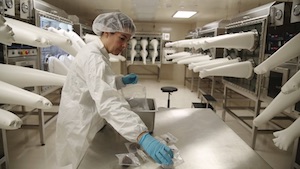 PHOTO: Gillian Brockell / The Washington Post / Getty Images
PHOTO: Gillian Brockell / The Washington Post / Getty ImagesCari Corrigan examines a rock in the National Museum of Natural History's meteorite clean room, which has a dozen cabinets filled with nitrogen gas. To access a rock, she plunges her hands into the long, white rubber gloves, passes the rock to an airlock and then opens the door. The cabinets protect the meteorites from contamination and the corrosive effects of our atmosphere.
STARSTRUCK BY PLANETARY SCIENCES
Thankfully, Corrigan’s no stranger to a little dirt.
The second of three children born to Linda, a grade-school teacher, and Mike, who worked for a siding company, Corrigan grew up on Gun Lake, halfway between Grand Rapids and Kalamazoo. She and her brothers rode bikes; caught frogs, turtles and fish; swam in the lake in the summer; and ice skated in the winter.
As an elementary schooler, Corrigan aspired to be an archaeologist—the result, she said, of exploring the woods with her brothers, unearthing bones and digging along the sandy shore.
It wasn’t until she enrolled at Michigan State University that she discovered a knack for science. She took classes in astronomy and geology, and when a professor introduced her to planetary sciences—a specialized field that combined those two disciplines, along with physics, chemistry, rocket science and biology—Corrigan was starstruck.
She switched her major from English and art to geology, and was randomly assigned an adviser, professor Michael Velbel, PhD. "When I told him my interests, he said, ‘You’ve walked into the office of the only person at the university who does anything planetary.’ " Velbel’s specialty? Meteorites.
The first time Corrigan looked under a microscope and saw a sample’s magnified minerals explode into a kaleidoscope of color—the geological equivalent of a stained-glass window—she was hooked.
"There’s been so much serendipity throughout my career," she said. "That was probably the first instance of it."
In 1995, a year before starting graduate school at Michigan State, Corrigan snagged a prestigious internship at the Lunar and Planetary Institute (LPI) in Houston. It proved to be fateful. Harvey and McCoy were both fellows at the Johnson Space Center and met Corrigan at an LPI event. After Corrigan finished her master’s degree in geology and decided to pursue a doctorate, she knew exactly where to study: Case Western Reserve.
"The prospect of studying Mars and traveling to Antarctica was an enticing combination," she said.
Corrigan found the university "more nurturing than competitive; it felt like a super supportive family with everyone rooting you on," she said. "And the intellectual breadth throughout the [College of Arts and Sciences] and across the university was enough that, even though my department was small, I had many people to draw on for social, academic and cultural support."
While her master’s thesis examined the Chicxulub impact crater, formed by a million-ton meteor that may have been responsible for the extinction of dinosaurs 65 million years ago, Corrigan’s dissertation focused on carbonate minerals in the famous 4-billion- year-old Allan Hills 84001 meteorite and what they reveal about water on Mars.
After earning her PhD, Corrigan did a postdoctoral fellowship at the National Museum of Natural History learning in part to classify Antarctic meteorites, then worked at the Johns Hopkins University Applied Physics Laboratory, developing instruments for spacecraft missions. She returned to the museum in 2008 as curator of Antarctic meteorites. It wouldn’t be long before she’d cross paths with ALH 84001 again.
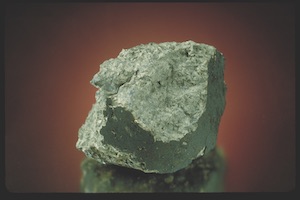 PHOTO: Courtesy of The Smithsonian Institution’s National Museum of Natural History
PHOTO: Courtesy of The Smithsonian Institution’s National Museum of Natural HistoryThe Allan Hills 84001 meteorite is from Mars and among the biggest rock stars in the Smithsonian's collection from Antarctica.
AN OUT-OF-THIS-WORLD LIBRARY
Every season, ANSMET teams collect an average of 550 rocks in Antarctica that ultimately end up in Corrigan’s lab. There, she determines their mineral composition and their meteorite type, which in turn indicates their age. (Chondrites, the most common type, are about 4.5 billion years old, predating anything on Earth.)
The mineral vault at the museum houses about 5,000 meteorites. Several hundred others—one as large as 2,564 pounds—are on display in the museum’s Janet Annenberg Hooker Hall of Geology, Gems, and Minerals. Most of the rest are stored 9 miles away, at the Smithsonian’s support center in suburban Maryland.
There, a meteorite clean room features a dozen cabinets filled with nitrogen gas, each with three pairs of long, white gloves that reach toward the center of the narrow room. When Corrigan needs to access a rock, she plunges her hands into the gloves and passes it to the airlock, then opens the cabinet door.
The most precious rocks, like Allan Hills 84001—named for the hills near the Transantarctic Mountains where it was found—are kept under heavy glass in a stainless-steel briefcase marked "United States government property."
ALH 84001 was discovered 35 years ago and gained its fame in 1996 when some scientists claimed to have found microbial fossils in the meteorite that pointed to the possibility of life on the red planet. While the hypotheses remained unproven, they sparked a new field of science: astrobiology, the study of life in the universe.
As curator of the collection, Corrigan is a member of NASA’s Meteorite Working Group, a committee of scientists who fi eld requests for samples from researchers. The group has loaned more than 10,000 specimens to scientists in 24 countries who base their requests on a biannual 30-page catalog—that Corrigan helps compile—of the ANSMET team’s most recently classified finds. She also fields museumgoers’ questions and helps create educational content to get youngsters fired up about planetary science.
"Cari is one of the most engaging people in our community," McCoy said. "She does a fantastic job conveying not just the initial excitement of finding a rock from outer space, but the continuing excitement of unraveling the story of these rocks."
Harvey agreed. "When the rocks are sent to her from Johnson Space Center, it’s like her birthday, Christmas and Halloween with a bucket full of candy, all in one."
In April 2017, the International Astronomical Union’s Minor Planet Center named an asteroid after her: 9924 Corrigan. It’s millions of miles overhead, orbiting the sun at 15 miles per second—but its namesake is modest about the extraterrestrial tribute.
"Mickey Mouse has one, too," she laughed. "But who knows, maybe someday a piece of it will end up in my lab."
One can only wonder what secrets it might reveal.
Magnified Minerals
Samples from Corrigan’s lab*
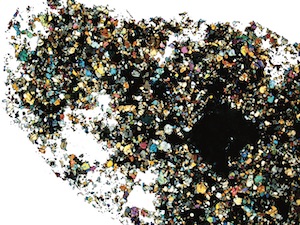
Detail 1: Meteorite Hills 01212 is an acapulcoite meteorite, a classification for rocks thought to have formed from the melting of an ordinary chondrite, which is the most common type of meteorite that falls to Earth.
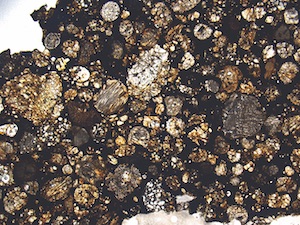
Detail 2: Meteorite Hills 00552, an ordinary chondrite. The circular features are chondrules, some of the oldest known solids to have formed in our solar system. This rock is estimated to have formed 4.5 billion years ago.
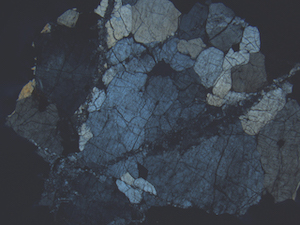
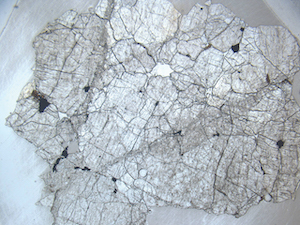
Details 3 and 4: Allan Hills 84001, a Martian igneous rock that in the 1990s was first believed to harbor signs of fossilized Martian life. It contains carbonates, which are our only hand sample evidence of liquid water on Mars. Igneous rocks are formed when extremely hot liquid cools.
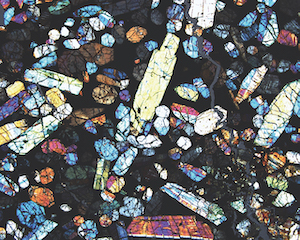
Detail 5: Miller Range 03346, an igneous rock from Mars.
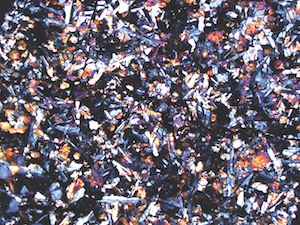
Detail 6: La Paz Ice Fields 02226, an igneous rock from the Moon.
*Each of these slices is the width of a human hair. The photographs were taken under a microscope, with images 1, 4, 5 and 6 shot with polarized light, which allows bright colors to pop out.
Images Courtesy of THE SMITHSONIAN INSTITUTION’S
NATIONAL MUSEUM OF NATURAL HISTORY





